人教版英语九年级中考时态专题课件(共22张PPT)
文档属性
| 名称 | 人教版英语九年级中考时态专题课件(共22张PPT) |  | |
| 格式 | pptx | ||
| 文件大小 | 37.6MB | ||
| 资源类型 | 教案 | ||
| 版本资源 | 人教新目标(Go for it)版 | ||
| 科目 | 英语 | ||
| 更新时间 | 2024-09-24 11:28:26 | ||
图片预览


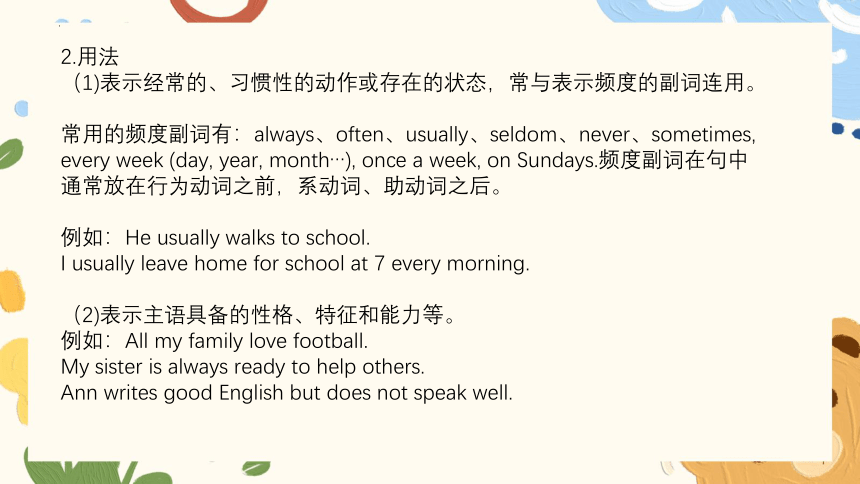

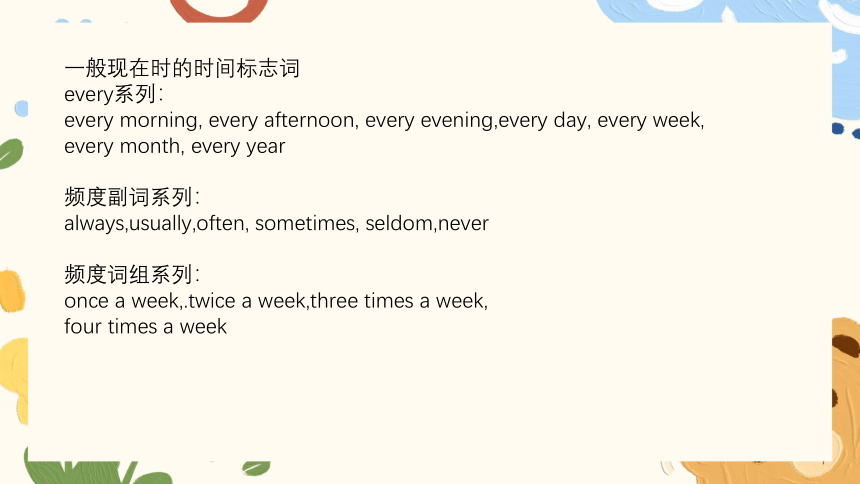

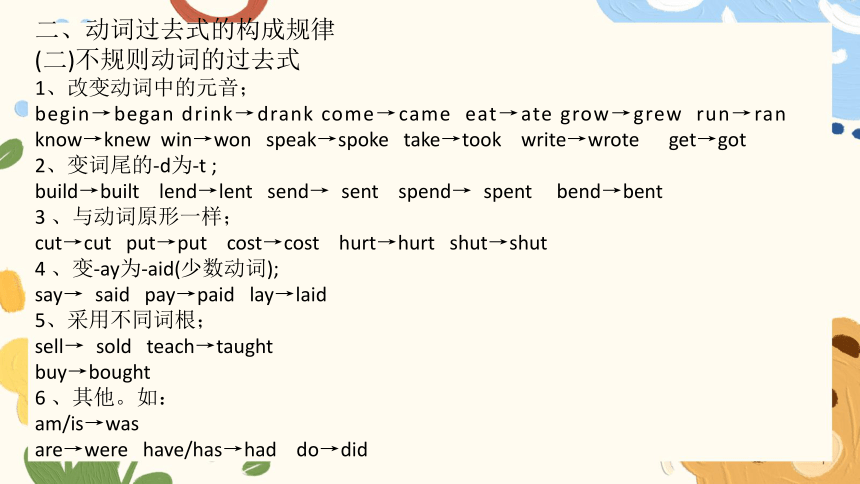
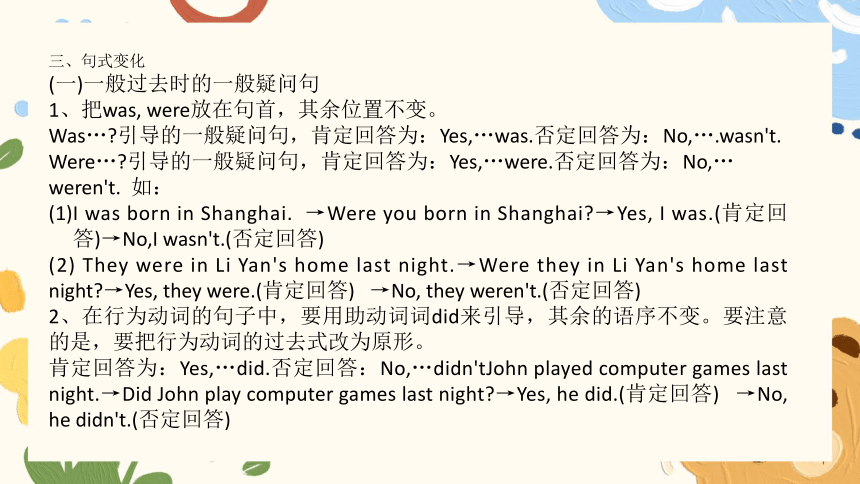
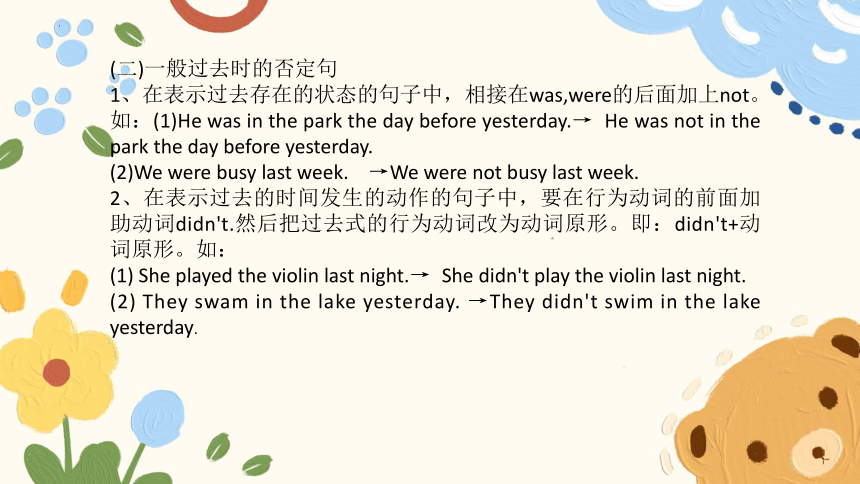
文档简介
(共22张PPT)
时态
一般现在时
There are many variations of passages of Lorem
1.结构
肯定句式:主语+动词原形/动词的第三人称单数+其他
否定句式:主语+(助动词)don't/doesn't+动词原形+其他
一般疑问句式:Do/Does+主语+动词原形+其他
特殊疑问句:特殊疑问词+do/does+主语+动词原形+其他
What do you do on weekends
简略回答:(肯)Yes,主语+do/does
(否)No,主语+do/does not
缩写形式: don't = do not
doesn't = does not
例句:He often goes swimming in summer.
I usually leave home for school at 7 every morning.
2.用法
(1)表示经常的、习惯性的动作或存在的状态,常与表示频度的副词连用。
常用的频度副词有:always、often、usually、seldom、never、sometimes, every week (day, year, month…), once a week, on Sundays.频度副词在句中通常放在行为动词之前,系动词、助动词之后。
例如:He usually walks to school.
I usually leave home for school at 7 every morning.
(2)表示主语具备的性格、特征和能力等。
例如:All my family love football.
My sister is always ready to help others.
Ann writes good English but does not speak well.
(3)表示客观真理、客观存在、自然现象。
例如:The earth moves around the sun.
Shanghai lies in the east of China.
4)表示按计划或安排好的,或将要发生的动作,可用一般现在时表将来。
但只限于start,begin,leave,go,come,arrive,return,take place等。
例如:The train leaves at six tomorrow morning.
He comes back tonight.
(5)在复合句中,当主句是一般将来时,时间或条件状语从句的谓语动词只能用一般现在时来表示将来要发生的动作。
例如: I'll tell him the news when he comes back.
一般现在时的时间标志词
every系列:
every morning, every afternoon, every evening,every day, every week, every month, every year
频度副词系列:
always,usually,often, sometimes, seldom,never
频度词组系列:
once a week,.twice a week,three times a week,
four times a week
一般过去时
一、概念
表示在的过去某个时间里所发生的动作或存在的状态。通常在句子里找到表示过去时间的词或词组。如:yesterday ,yesterday morning,yesterday afternoon,yesterday evening,the day before yesterday(前天), last night, last week, last month, last year, a momentago(刚才),just now(刚才), two days ago,a week ago ,in 1990等。
二、动词过去式的构成规律
(一)规则动词的过去式
1、一般情况下,在动词原形后面加-ed;如:look→looked play→played;
2、以不发音e结尾的动词,在词尾直接加-d;如:live→lived use→used;
3、以“辅音字母+y”结尾的动词,先将y改为i,再加-ed;如:study→studied, try→tried fly→flied
4、以重读闭音节(即辅音+元音+辅音)或r音节结尾,末尾只有一个辅音字母的动词,要先双写这个辅音字母后,再加-ed。如:stop→ stopped plan→planned;
二、动词过去式的构成规律
(二)不规则动词的过去式
1、改变动词中的元音;
begin→began drink→drank come→came eat→ate grow→grew run→ran know→knew win→won speak→spoke take→took write→wrote get→got
2、变词尾的-d为-t ;
build→built lend→lent send→ sent spend→ spent bend→bent
3 、与动词原形一样;
cut→cut put→put cost→cost hurt→hurt shut→shut
4 、变-ay为-aid(少数动词);
say→ said pay→paid lay→laid
5、采用不同词根;
sell→ sold teach→taught
buy→bought
6 、其他。如:
am/is→was
are→were have/has→had do→did
三、句式变化
(一)一般过去时的一般疑问句
1、把was, were放在句首,其余位置不变。
Was… 引导的一般疑问句,肯定回答为:Yes,…was.否定回答为:No,….wasn't.
Were… 引导的一般疑问句,肯定回答为:Yes,…were.否定回答为:No,…
weren't. 如:
I was born in Shanghai. →Were you born in Shanghai →Yes, I was.(肯定回答)→No,I wasn't.(否定回答)
(2) They were in Li Yan's home last night.→Were they in Li Yan's home last night →Yes, they were.(肯定回答) →No, they weren't.(否定回答)
2、在行为动词的句子中,要用助动词词did来引导,其余的语序不变。要注意的是,要把行为动词的过去式改为原形。
肯定回答为:Yes,…did.否定回答:No,…didn'tJohn played computer games last night.→Did John play computer games last night →Yes, he did.(肯定回答) →No, he didn't.(否定回答)
(二)一般过去时的否定句
1、在表示过去存在的状态的句子中,相接在was,were的后面加上not。
如:(1)He was in the park the day before yesterday.→ He was not in the park the day before yesterday.
(2)We were busy last week. →We were not busy last week.
2、在表示过去的时间发生的动作的句子中,要在行为动词的前面加助动词didn't.然后把过去式的行为动词改为动词原形。即:didn't+动词原形。如:
(1) She played the violin last night.→ She didn't play the violin last night.
(2) They swam in the lake yesterday. →They didn't swim in the lake yesterday.
(三)一般过去式的特殊疑问句
1.What did… (主要是询问过去发生了什么事情,注意要把过去式改为动词原形。)We ate Chinese food last night. →What did we eat last night
2.Where did… (主要是询问过去事情发生的地方。)They sang and danced in the music room yesterday morning.→ Where did they sing and dance yesterday morning
3.Who+动词过去式… (主要是询问过去事情发生的人物。)Mike and Tom climbed mountains last weekend.→Who climbed mountains last weekend
四、句子结构
1、在表示某个时间里存在的状态的句子,系动词用过式was ,were构成。如:
(1) I was stay at home yesterday. 昨天我在家。
(2) We were in the gym just now.刚才我们在体育馆。
2、在表示过去某个时间里发生的动作,用动词的过去式构成。如: I visited my uncle yesterday.昨天我拜访了我的叔叔。
一般将来时
1.概念:表示将要发生的动作或存在的状态及打算、计划或准备做某事。
2.时间状语:tomorrow , next day(week, month, year), soon, in a few minutes , by the day after tomorrow 等等。
3.基本结构;①am/is/are/going to+do;②will+do。
否定形式:①am/is/are + not+ going to+do
②will not(won't)+ do。
一般疑问句:①am/is/are放于句首;②will提到句首。
4.will主要用于在以下三个方面:
(1)表示主观意愿的将来。
They will go to visit the factory tomorrow.明天他们将去厂参观工厂。
I'll come with Wang Bing , Liu Tao and Yang Ling我将和王兵、刘涛、杨玲一起来。
(2)表示不以人的意志为转移的客观的将来。
Today is Saturday. Tomorrow will be Sunday.
(3)表示临时决定,通常用于对话中。
—Mary has been ill for a week.玛丽病了一周了。
—Oh, I didn't know . I will go and see her.噢,我不知道。我去看看她。
5.be going to主要用于一下两个方面:
(1)表示事先经过考虑、安排好打算、计划要做某事。
Dad and I are going to watch an opera this afternoon.今天下午我和爸爸打算去看歌剧。
(2)表示根据目前某种迹象判断,某事非常有可能发生,表示推测。
Look! There come the dark clouds. It is going to rain.
瞧!乌云密集,天要下雨了。
现在进行时
1.概念:表示现阶段或说话时正在进行的动作及行为。
2.时间状语:now, at this time, these days, etc。
3.基本结构:am/is/are+doing
否定形式:am/is/are+not+ doing。
一般疑问句:把be动词放于句首。
4.用法:
1)表示现在(指说话人说话时)正在发生的事情。例如:We are waiting for you.我们正在等你。
2)习惯进行:表示长期的或重复性的动作,说话时动作未必正在进行。
Mr.Green is writing another novel.他在写另一部小说。(说话时并未在写,只处于写作的状态。)
3)表示渐变,这样的动词有:get,grow,become,turn, run,go, begin等。
The leaves are turning red.叶子在变红。
It's getting warmer and warmer.天越来越热了。
(4)与always, constantly,forever等词连用,表示反复发生的动作或持续存在的状态,往往带有说话人的主观色彩。
You are always changing your mind。你老是改变主意。
(5)用现在进行时表示将来下列动词come,go, arrive,leave,start, begin,return等瞬时动词的现在进行时可以表示将来。
I'm leaving tomorrow.明天我要走了。
Are you staying here till next week 你会在这儿呆到下周吗
过去进行时
1.概念:表示过去某段时间或某一时刻正在发生或进行的行为或动作。
My brother fell while he was riding his bicycle and hurt himself.我兄弟骑车时摔了下来,受了伤。
When I got to the top of the mountain, the sun was shining.我到达山顶时,阳光灿烂。
2.时间状语:at this time yesterday, at that time或以when引导的谓语动词是一般过去时的时间状语等。
3.基本结构:was/were+doing
否定形式:was/were+not+doing
一般疑问句:把was或were放于句首。
4.用法
1)过去进行时表示过去某段时间内持续进行的动作或者事情。
We were watching TV from seven to nine last night.昨晚七到九点我们在看电视。
2)过去进行时可以表示在过去某个时间点发生的事情。时间点可以用介词短语、副词或从句来表示。
What was she doing at nine o'clock yesterday 昨天晚上九点她在做什么
(介词短语表示时间点)She was doing her homework then.那个时候她正在写作业。
(副词表示时间点)When I saw him,he was decorating his room.当我看见他的时候他正在装饰房间。(when从句表示时间点)
(3)在复合句中,如果主要动作和背景动作都是延续的或同时发生的,那么主从句的动词都可用过去进行时。
When he was waiting for the bus, he was reading a newspaper.他边等车边看报。
(两个动作都是延续的)He was cleaning his car while I was cooking.他擦车时我在做饭。
(两个动作同时进行)
现在完成时
一 . 基本意义和句式结构
1.现在完成时的意义:表示已发生或完成的某一动作,强调对现在造成的影响和结果。
2. 现在完成时的结构(助动词 have/has+动词的过去分词 done
肯定句:主语+ has/have done sth.
否定句: 主 语 +has/have not done sth.(have not=haven't)
一般疑问句:Have/Has +主语+done sth.
特殊疑问句:特殊疑问词(非主语) +have/has+ 主语 done sth.
例: How long have they been here
What has Tony learnt this term, Miss White
二.应用
1. 常与现在完成时连用的时间状语有 recently(最近),lately(近来),so far(至今),up to now(至今),today, this morning, this week, in the past/last....., already, yet,never,ever,just, before 等连用。
2. 现在完成时的用法
(1)可以和 already, yet,just 等连用。 already 一般用于肯定句,yet 一般用于否定句和疑问句, just 表示时间较短的。 例 :I have already posted the photos.
- Have you had your lunch yet -- Yes, I have. I've just had it.
(2)表示继续,可以和 today, this morning,these days, in the last/past..., since, for, so far, up to now 等连用。
例: She's worked in the company for over two years.
They've lived here since 1989.
So far we have learnt more than 3,000 French words.
In the last/past few years, great changes have taken place in our country.
(3)表示经验,过去到现在之间曾经经历过的事情,常和 never,ever, once, three times, before 等词连用。
例 :I have never been to Egypt before.
Have you ever drunk
3. 表示“ 一个动作发生在过去, 一直延续到现在”, since+ 时 间 点 ,for+ 一 段 时 间 。
① since+ 时 间 点
例: I have worked in the company since 2009.
② for+ 一段时间
例 :We have lived in Guangzhou for 5 years.
They have waited at the airport for half an hour.
He has been away from his hometown for over 20 years.
4.现在完成时中,for和since引导的时间状语要与延续性动词连用。常见的延续性动词有be,live, work, stay, study, teach, pass, wait, stand等。例:Two months has passed since we arrived here.
Mr. Brown has taught art in the college for nearly 30 years.有些瞬间动词在和since或for连用时,需要转化成延续性动词
become—be
borrow—keep
break—be broken
close—be closed
arrive/come—be here/there
die—be dead
get up—be up
join—be in/be a member of
lose—be lost
marry—be married
open—be opened
buy—have
go/leave—be away
begin/start—be on
5.高频考点:have/has been to “去过某地”,人已经回来了。have/has gone to “去了某地”,人不在此地。have/has been in "呆在某地多长时间"
例:Jack has been to New Zealand several times.
She has gone to Wuhan and will come back to Guangzhou in two weeks.
We have been in Guangzhou for nearly six years.
6.现在完成时与一般过去时的区别
①一般过去时只表示过去的动作或状态;现在完成时强调过去的动作产生的结果或对现在的影响。例:I lost my purse.(钱包是过去丢的,现在是否找到,不知道。)
I have lost my purse.(钱包是过去丢的,现在还没找到。)
Mrs. Smith lived in Kentucky for seven years.(现在不住在肯塔基州)
Mrs. Smith has lived in Kentucky for seven years.(现在还住在肯塔基州)
②如果动作发生在特定的过去时间(last night, yesterday, three days ago, then, just now, in 1890),必须用一般过去时。
例: The film began ten minutes ago. Who knocked at the door just now
③询问某事过去发生的具体时间,具体地点时必须用一般过去时。
例:When did you arrive at the village Where did they leave for
④ago和before
ago,副词,不能单独使用,用于“名词短语+ago”,句子用一般过去时;用于“since+数词或名词短语+ago”,句子用现在完成时。
例:I visited the Science Museum two days ago.Lucy has waited for the bus since two hours ago.
before,副词&连词,可以单独使用,意为"以前,在…之前"。
例:I have visited the Science Museum before.
过去完成时
1.概念:以过去某个时间为标准,在此以前发生的动作或行为,或在过去某动作之前完成的行为,即"过去的过去"。
2.时间状语:before, by the end of last year(term, month), ctc。
3.基本结构:had+ done
否定形式:had+not+done 一般疑问句:had放于句首
4.用法
(1)在told, said, knew, heard, thought等动词后的宾语从句中。
例如:She said (that)she had never been to Paris.她告诉我她曾去过巴黎。
(2)在过去不同时间发生的两个动作中,发生在先,用过去完成时;发生在后,用一般过去时。例如:When the police arrived, the thieves had run away.警察到达时,小偷们早就跑了。
(3)表示意向的动词,如hope,wish, expect, think, intend, mean, suppose等,用过去完成时表示"原本..,未能."。
例如:We had hoped that you would come, but you didn't.那时我们希望你能来,但是你没有来。
注意:had hardly…when…刚…就…。
例:I had hardly opened the door when he hit me.我刚打开门,他就打了我。
had no sooner…than刚……就……。
例:He had no sooner bought the car than he sold it.他刚买了这辆车,转眼又卖了。
时态
一般现在时
There are many variations of passages of Lorem
1.结构
肯定句式:主语+动词原形/动词的第三人称单数+其他
否定句式:主语+(助动词)don't/doesn't+动词原形+其他
一般疑问句式:Do/Does+主语+动词原形+其他
特殊疑问句:特殊疑问词+do/does+主语+动词原形+其他
What do you do on weekends
简略回答:(肯)Yes,主语+do/does
(否)No,主语+do/does not
缩写形式: don't = do not
doesn't = does not
例句:He often goes swimming in summer.
I usually leave home for school at 7 every morning.
2.用法
(1)表示经常的、习惯性的动作或存在的状态,常与表示频度的副词连用。
常用的频度副词有:always、often、usually、seldom、never、sometimes, every week (day, year, month…), once a week, on Sundays.频度副词在句中通常放在行为动词之前,系动词、助动词之后。
例如:He usually walks to school.
I usually leave home for school at 7 every morning.
(2)表示主语具备的性格、特征和能力等。
例如:All my family love football.
My sister is always ready to help others.
Ann writes good English but does not speak well.
(3)表示客观真理、客观存在、自然现象。
例如:The earth moves around the sun.
Shanghai lies in the east of China.
4)表示按计划或安排好的,或将要发生的动作,可用一般现在时表将来。
但只限于start,begin,leave,go,come,arrive,return,take place等。
例如:The train leaves at six tomorrow morning.
He comes back tonight.
(5)在复合句中,当主句是一般将来时,时间或条件状语从句的谓语动词只能用一般现在时来表示将来要发生的动作。
例如: I'll tell him the news when he comes back.
一般现在时的时间标志词
every系列:
every morning, every afternoon, every evening,every day, every week, every month, every year
频度副词系列:
always,usually,often, sometimes, seldom,never
频度词组系列:
once a week,.twice a week,three times a week,
four times a week
一般过去时
一、概念
表示在的过去某个时间里所发生的动作或存在的状态。通常在句子里找到表示过去时间的词或词组。如:yesterday ,yesterday morning,yesterday afternoon,yesterday evening,the day before yesterday(前天), last night, last week, last month, last year, a momentago(刚才),just now(刚才), two days ago,a week ago ,in 1990等。
二、动词过去式的构成规律
(一)规则动词的过去式
1、一般情况下,在动词原形后面加-ed;如:look→looked play→played;
2、以不发音e结尾的动词,在词尾直接加-d;如:live→lived use→used;
3、以“辅音字母+y”结尾的动词,先将y改为i,再加-ed;如:study→studied, try→tried fly→flied
4、以重读闭音节(即辅音+元音+辅音)或r音节结尾,末尾只有一个辅音字母的动词,要先双写这个辅音字母后,再加-ed。如:stop→ stopped plan→planned;
二、动词过去式的构成规律
(二)不规则动词的过去式
1、改变动词中的元音;
begin→began drink→drank come→came eat→ate grow→grew run→ran know→knew win→won speak→spoke take→took write→wrote get→got
2、变词尾的-d为-t ;
build→built lend→lent send→ sent spend→ spent bend→bent
3 、与动词原形一样;
cut→cut put→put cost→cost hurt→hurt shut→shut
4 、变-ay为-aid(少数动词);
say→ said pay→paid lay→laid
5、采用不同词根;
sell→ sold teach→taught
buy→bought
6 、其他。如:
am/is→was
are→were have/has→had do→did
三、句式变化
(一)一般过去时的一般疑问句
1、把was, were放在句首,其余位置不变。
Was… 引导的一般疑问句,肯定回答为:Yes,…was.否定回答为:No,….wasn't.
Were… 引导的一般疑问句,肯定回答为:Yes,…were.否定回答为:No,…
weren't. 如:
I was born in Shanghai. →Were you born in Shanghai →Yes, I was.(肯定回答)→No,I wasn't.(否定回答)
(2) They were in Li Yan's home last night.→Were they in Li Yan's home last night →Yes, they were.(肯定回答) →No, they weren't.(否定回答)
2、在行为动词的句子中,要用助动词词did来引导,其余的语序不变。要注意的是,要把行为动词的过去式改为原形。
肯定回答为:Yes,…did.否定回答:No,…didn'tJohn played computer games last night.→Did John play computer games last night →Yes, he did.(肯定回答) →No, he didn't.(否定回答)
(二)一般过去时的否定句
1、在表示过去存在的状态的句子中,相接在was,were的后面加上not。
如:(1)He was in the park the day before yesterday.→ He was not in the park the day before yesterday.
(2)We were busy last week. →We were not busy last week.
2、在表示过去的时间发生的动作的句子中,要在行为动词的前面加助动词didn't.然后把过去式的行为动词改为动词原形。即:didn't+动词原形。如:
(1) She played the violin last night.→ She didn't play the violin last night.
(2) They swam in the lake yesterday. →They didn't swim in the lake yesterday.
(三)一般过去式的特殊疑问句
1.What did… (主要是询问过去发生了什么事情,注意要把过去式改为动词原形。)We ate Chinese food last night. →What did we eat last night
2.Where did… (主要是询问过去事情发生的地方。)They sang and danced in the music room yesterday morning.→ Where did they sing and dance yesterday morning
3.Who+动词过去式… (主要是询问过去事情发生的人物。)Mike and Tom climbed mountains last weekend.→Who climbed mountains last weekend
四、句子结构
1、在表示某个时间里存在的状态的句子,系动词用过式was ,were构成。如:
(1) I was stay at home yesterday. 昨天我在家。
(2) We were in the gym just now.刚才我们在体育馆。
2、在表示过去某个时间里发生的动作,用动词的过去式构成。如: I visited my uncle yesterday.昨天我拜访了我的叔叔。
一般将来时
1.概念:表示将要发生的动作或存在的状态及打算、计划或准备做某事。
2.时间状语:tomorrow , next day(week, month, year), soon, in a few minutes , by the day after tomorrow 等等。
3.基本结构;①am/is/are/going to+do;②will+do。
否定形式:①am/is/are + not+ going to+do
②will not(won't)+ do。
一般疑问句:①am/is/are放于句首;②will提到句首。
4.will主要用于在以下三个方面:
(1)表示主观意愿的将来。
They will go to visit the factory tomorrow.明天他们将去厂参观工厂。
I'll come with Wang Bing , Liu Tao and Yang Ling我将和王兵、刘涛、杨玲一起来。
(2)表示不以人的意志为转移的客观的将来。
Today is Saturday. Tomorrow will be Sunday.
(3)表示临时决定,通常用于对话中。
—Mary has been ill for a week.玛丽病了一周了。
—Oh, I didn't know . I will go and see her.噢,我不知道。我去看看她。
5.be going to主要用于一下两个方面:
(1)表示事先经过考虑、安排好打算、计划要做某事。
Dad and I are going to watch an opera this afternoon.今天下午我和爸爸打算去看歌剧。
(2)表示根据目前某种迹象判断,某事非常有可能发生,表示推测。
Look! There come the dark clouds. It is going to rain.
瞧!乌云密集,天要下雨了。
现在进行时
1.概念:表示现阶段或说话时正在进行的动作及行为。
2.时间状语:now, at this time, these days, etc。
3.基本结构:am/is/are+doing
否定形式:am/is/are+not+ doing。
一般疑问句:把be动词放于句首。
4.用法:
1)表示现在(指说话人说话时)正在发生的事情。例如:We are waiting for you.我们正在等你。
2)习惯进行:表示长期的或重复性的动作,说话时动作未必正在进行。
Mr.Green is writing another novel.他在写另一部小说。(说话时并未在写,只处于写作的状态。)
3)表示渐变,这样的动词有:get,grow,become,turn, run,go, begin等。
The leaves are turning red.叶子在变红。
It's getting warmer and warmer.天越来越热了。
(4)与always, constantly,forever等词连用,表示反复发生的动作或持续存在的状态,往往带有说话人的主观色彩。
You are always changing your mind。你老是改变主意。
(5)用现在进行时表示将来下列动词come,go, arrive,leave,start, begin,return等瞬时动词的现在进行时可以表示将来。
I'm leaving tomorrow.明天我要走了。
Are you staying here till next week 你会在这儿呆到下周吗
过去进行时
1.概念:表示过去某段时间或某一时刻正在发生或进行的行为或动作。
My brother fell while he was riding his bicycle and hurt himself.我兄弟骑车时摔了下来,受了伤。
When I got to the top of the mountain, the sun was shining.我到达山顶时,阳光灿烂。
2.时间状语:at this time yesterday, at that time或以when引导的谓语动词是一般过去时的时间状语等。
3.基本结构:was/were+doing
否定形式:was/were+not+doing
一般疑问句:把was或were放于句首。
4.用法
1)过去进行时表示过去某段时间内持续进行的动作或者事情。
We were watching TV from seven to nine last night.昨晚七到九点我们在看电视。
2)过去进行时可以表示在过去某个时间点发生的事情。时间点可以用介词短语、副词或从句来表示。
What was she doing at nine o'clock yesterday 昨天晚上九点她在做什么
(介词短语表示时间点)She was doing her homework then.那个时候她正在写作业。
(副词表示时间点)When I saw him,he was decorating his room.当我看见他的时候他正在装饰房间。(when从句表示时间点)
(3)在复合句中,如果主要动作和背景动作都是延续的或同时发生的,那么主从句的动词都可用过去进行时。
When he was waiting for the bus, he was reading a newspaper.他边等车边看报。
(两个动作都是延续的)He was cleaning his car while I was cooking.他擦车时我在做饭。
(两个动作同时进行)
现在完成时
一 . 基本意义和句式结构
1.现在完成时的意义:表示已发生或完成的某一动作,强调对现在造成的影响和结果。
2. 现在完成时的结构(助动词 have/has+动词的过去分词 done
肯定句:主语+ has/have done sth.
否定句: 主 语 +has/have not done sth.(have not=haven't)
一般疑问句:Have/Has +主语+done sth.
特殊疑问句:特殊疑问词(非主语) +have/has+ 主语 done sth.
例: How long have they been here
What has Tony learnt this term, Miss White
二.应用
1. 常与现在完成时连用的时间状语有 recently(最近),lately(近来),so far(至今),up to now(至今),today, this morning, this week, in the past/last....., already, yet,never,ever,just, before 等连用。
2. 现在完成时的用法
(1)可以和 already, yet,just 等连用。 already 一般用于肯定句,yet 一般用于否定句和疑问句, just 表示时间较短的。 例 :I have already posted the photos.
- Have you had your lunch yet -- Yes, I have. I've just had it.
(2)表示继续,可以和 today, this morning,these days, in the last/past..., since, for, so far, up to now 等连用。
例: She's worked in the company for over two years.
They've lived here since 1989.
So far we have learnt more than 3,000 French words.
In the last/past few years, great changes have taken place in our country.
(3)表示经验,过去到现在之间曾经经历过的事情,常和 never,ever, once, three times, before 等词连用。
例 :I have never been to Egypt before.
Have you ever drunk
3. 表示“ 一个动作发生在过去, 一直延续到现在”, since+ 时 间 点 ,for+ 一 段 时 间 。
① since+ 时 间 点
例: I have worked in the company since 2009.
② for+ 一段时间
例 :We have lived in Guangzhou for 5 years.
They have waited at the airport for half an hour.
He has been away from his hometown for over 20 years.
4.现在完成时中,for和since引导的时间状语要与延续性动词连用。常见的延续性动词有be,live, work, stay, study, teach, pass, wait, stand等。例:Two months has passed since we arrived here.
Mr. Brown has taught art in the college for nearly 30 years.有些瞬间动词在和since或for连用时,需要转化成延续性动词
become—be
borrow—keep
break—be broken
close—be closed
arrive/come—be here/there
die—be dead
get up—be up
join—be in/be a member of
lose—be lost
marry—be married
open—be opened
buy—have
go/leave—be away
begin/start—be on
5.高频考点:have/has been to “去过某地”,人已经回来了。have/has gone to “去了某地”,人不在此地。have/has been in "呆在某地多长时间"
例:Jack has been to New Zealand several times.
She has gone to Wuhan and will come back to Guangzhou in two weeks.
We have been in Guangzhou for nearly six years.
6.现在完成时与一般过去时的区别
①一般过去时只表示过去的动作或状态;现在完成时强调过去的动作产生的结果或对现在的影响。例:I lost my purse.(钱包是过去丢的,现在是否找到,不知道。)
I have lost my purse.(钱包是过去丢的,现在还没找到。)
Mrs. Smith lived in Kentucky for seven years.(现在不住在肯塔基州)
Mrs. Smith has lived in Kentucky for seven years.(现在还住在肯塔基州)
②如果动作发生在特定的过去时间(last night, yesterday, three days ago, then, just now, in 1890),必须用一般过去时。
例: The film began ten minutes ago. Who knocked at the door just now
③询问某事过去发生的具体时间,具体地点时必须用一般过去时。
例:When did you arrive at the village Where did they leave for
④ago和before
ago,副词,不能单独使用,用于“名词短语+ago”,句子用一般过去时;用于“since+数词或名词短语+ago”,句子用现在完成时。
例:I visited the Science Museum two days ago.Lucy has waited for the bus since two hours ago.
before,副词&连词,可以单独使用,意为"以前,在…之前"。
例:I have visited the Science Museum before.
过去完成时
1.概念:以过去某个时间为标准,在此以前发生的动作或行为,或在过去某动作之前完成的行为,即"过去的过去"。
2.时间状语:before, by the end of last year(term, month), ctc。
3.基本结构:had+ done
否定形式:had+not+done 一般疑问句:had放于句首
4.用法
(1)在told, said, knew, heard, thought等动词后的宾语从句中。
例如:She said (that)she had never been to Paris.她告诉我她曾去过巴黎。
(2)在过去不同时间发生的两个动作中,发生在先,用过去完成时;发生在后,用一般过去时。例如:When the police arrived, the thieves had run away.警察到达时,小偷们早就跑了。
(3)表示意向的动词,如hope,wish, expect, think, intend, mean, suppose等,用过去完成时表示"原本..,未能."。
例如:We had hoped that you would come, but you didn't.那时我们希望你能来,但是你没有来。
注意:had hardly…when…刚…就…。
例:I had hardly opened the door when he hit me.我刚打开门,他就打了我。
had no sooner…than刚……就……。
例:He had no sooner bought the car than he sold it.他刚买了这辆车,转眼又卖了。
同课章节目录
- 词法
- 名词
- 动词和动词短语
- 动词语态
- 动词时态
- 助动词和情态动词
- 非谓语动词
- 冠词
- 代词
- 数词和量词
- 形容词副词及其比较等级
- 介词和介词短语
- 连词和感叹词
- 构词法
- 相似、相近词比较
- 句法
- 陈述句
- 一般疑问句和否定疑问句
- 特殊疑问句及选择疑问句
- 反意疑问句
- 存在句(There be句型)
- 宾语从句
- 定语从句
- 状语从句
- 主谓一致问题
- 简单句
- 并列句
- 复合句
- 主谓一致
- 主、表语从句
- 名词性从句
- 直接引语和间接引语
- 虚拟语气
- 感叹句
- 强调句
- 倒装句
- 祈使句
- 句子的成分
- 句子的分类
- 题型专区
- 单项选择部分
- 易错题
- 完形填空
- 阅读理解
- 词汇练习
- 听说训练
- 句型转换
- 补全对话
- 短文改错
- 翻译
- 书面表达
- 任务型阅读
- 语法填空
- 其他资料
